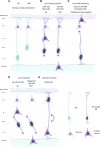Radial glia progenitor polarity in health and disease
- PMID: 39416687
- PMCID: PMC11479994
- DOI: 10.3389/fcell.2024.1478283
Radial glia progenitor polarity in health and disease
Abstract
Radial glia (RG) are the main progenitor cell type in the developing cortex. These cells are highly polarized, with a long basal process spanning the entire thickness of the cortex and acting as a support for neuronal migration. The RG cell terminates by an endfoot that contacts the pial (basal) surface. A shorter apical process also terminates with an endfoot that faces the ventricle, with a primary cilium protruding in the cerebrospinal fluid. These cell domains have particular subcellular compositions that are critical for the correct functioning of RG. When altered, this can affect proper development of the cortex, ultimately leading to cortical malformations, associated with different pathological outcomes. In this review, we focus on the current knowledge concerning the cell biology of these bipolar stem cells and discuss the role of their polarity in health and disease.
Keywords: cortical development; cortical malformations; local translation; neuronal migration; organelles; proliferation.
Copyright © 2024 Viola, Chinnappa and Francis.
Conflict of interest statement
The authors declare that the research was conducted in the absence of any commercial or financial relationships that could be construed as a potential conflict of interest.
Figures



References
Publication types
LinkOut - more resources
Full Text Sources

